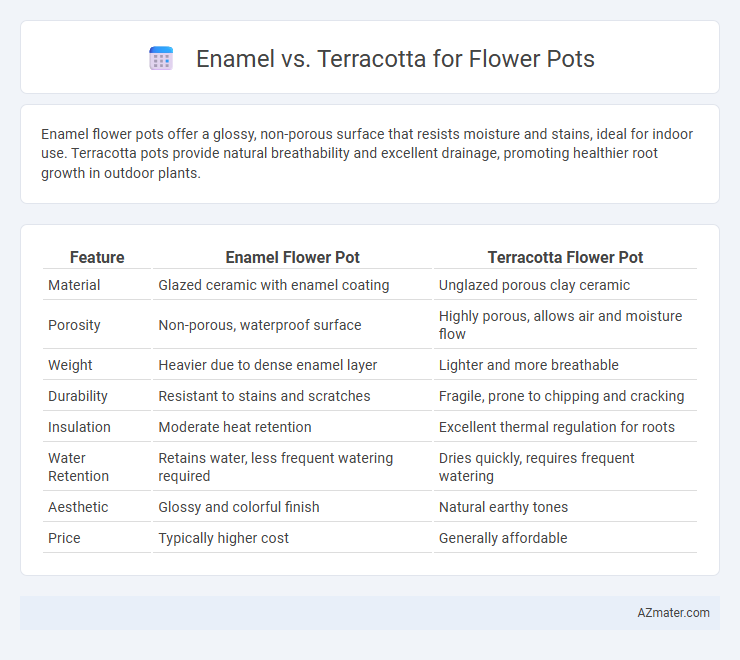Enamel flower pots offer a glossy, non-porous surface that resists moisture and stains, ideal for indoor use. Terracotta pots provide natural breathability and excellent drainage, promoting healthier root growth in outdoor plants.
Table of Comparison
| Feature | Enamel Flower Pot | Terracotta Flower Pot |
|---|---|---|
| Material | Glazed ceramic with enamel coating | Unglazed porous clay ceramic |
| Porosity | Non-porous, waterproof surface | Highly porous, allows air and moisture flow |
| Weight | Heavier due to dense enamel layer | Lighter and more breathable |
| Durability | Resistant to stains and scratches | Fragile, prone to chipping and cracking |
| Insulation | Moderate heat retention | Excellent thermal regulation for roots |
| Water Retention | Retains water, less frequent watering required | Dries quickly, requires frequent watering |
| Aesthetic | Glossy and colorful finish | Natural earthy tones |
| Price | Typically higher cost | Generally affordable |
Introduction to Flower Pot Materials
Enamel flower pots offer a smooth, glossy finish with excellent durability and resistance to rust, making them ideal for indoor and outdoor use. Terracotta pots provide natural breathability and moisture regulation due to their porous nature, promoting healthier root systems for plants. Choosing between enamel and terracotta depends on factors like aesthetic preference, plant type, and environmental conditions, with enamel excelling in modern decor and terracotta favored for traditional gardening.
What is Enamel? Key Characteristics
Enamel is a durable, glass-like coating fused onto metal or ceramic surfaces through high-temperature firing, providing a smooth, glossy finish resistant to chipping and corrosion. Key characteristics include its non-porous nature, vibrant color retention, and ease of cleaning, making it ideal for decorative and functional flower pots. Enamel pots offer enhanced protection against moisture and weathering compared to terracotta, which is porous and prone to cracking over time.
Understanding Terracotta: Properties and Origins
Terracotta, a porous clay material fired at low temperatures, is renowned for its natural breathability and moisture regulation, making it ideal for flower pots. Originating from ancient civilizations, terracotta's distinctive reddish-brown hue and porous texture allow air and water to pass through, promoting healthy root growth and preventing soil rot. Its durability and natural insulation properties help maintain optimal soil temperature, ensuring the well-being of plants in various climates.
Aesthetic Differences: Enamel vs Terracotta
Enamel flower pots offer a sleek, glossy finish with vibrant color options that enhance modern and contemporary garden aesthetics. Terracotta pots provide a natural, earthy appearance with warm reddish-brown tones, promoting a rustic and traditional charm. The smooth, reflective surface of enamel contrasts with the porous, matte texture of terracotta, significantly influencing visual appeal and style versatility in garden decor.
Durability and Longevity Comparison
Enamel flower pots feature a smooth, glassy coating that offers superior resistance to water, stains, and chipping, enhancing their durability in both indoor and outdoor settings. Terracotta pots are porous and prone to cracking in freezing temperatures but provide excellent breathability, promoting healthier root systems and longevity in temperate climates. While enamel pots maintain structural integrity longer under harsh conditions, terracotta's natural material can last decades with proper care and protection from extreme weather.
Impact on Plant Health: Breathability and Drainage
Terracotta flower pots offer superior breathability and natural moisture regulation due to their porous structure, which promotes healthy root oxygenation and reduces the risk of root rot. Enamel pots, coated with a non-porous glaze, retain moisture longer but may limit airflow and drainage, potentially causing waterlogging and hindering plant health. Choosing terracotta pots benefits plants requiring well-drained soil and aeration, while enamel pots suit moisture-loving plants if proper drainage holes are ensured.
Weight and Portability Considerations
Enamel flower pots are generally lighter and more portable due to their thin metal base coated with enamel, making them easier to move around for indoor and outdoor use. Terracotta pots, made from baked clay, tend to be heavier and more fragile, which limits their portability but provides better stability for larger plants. Choosing between enamel and terracotta depends on whether you prioritize lightweight convenience or durable stability for your gardening needs.
Maintenance and Cleaning Needs
Enamel flower pots require minimal maintenance as their smooth, non-porous surface resists dirt and stains, making cleaning easy with just mild soap and water. Terracotta pots are porous and absorb moisture, often developing mineral deposits and algae, necessitating regular scrubbing and occasional soaking in vinegar solutions to remove buildup. Frequent maintenance for terracotta includes sealing to prevent cracking, whereas enamel pots maintain their appearance longer with less effort.
Cost Comparison: Enamel vs Terracotta Pots
Enamel flower pots typically cost more than terracotta pots due to their durable coating and vibrant finish, with prices ranging from $15 to $40 compared to terracotta's $5 to $20 per pot. Terracotta pots are made from natural clay, making them more affordable and widely available, but they may require more maintenance due to porosity and breakability. Enamel pots offer longevity and aesthetic appeal, justifying the higher initial investment for gardeners seeking stylish, long-lasting options.
Choosing the Best Pot: Factors to Consider
Enamel flower pots offer a sleek, non-porous surface that prevents moisture loss, making them ideal for plants requiring consistent hydration, while terracotta pots provide excellent breathability and natural insulation due to their porous clay composition. When choosing the best pot, consider factors like plant type, water retention needs, and durability; terracotta suits drought-tolerant species by allowing soil airflow, whereas enamel is better for humidity-loving plants and modern decor. Weighing the pros of moisture control, weight, and aesthetic preference ensures optimal growth conditions and long-term pot performance.

Infographic: Enamel vs Terracotta for Flower Pot
 azmater.com
azmater.com